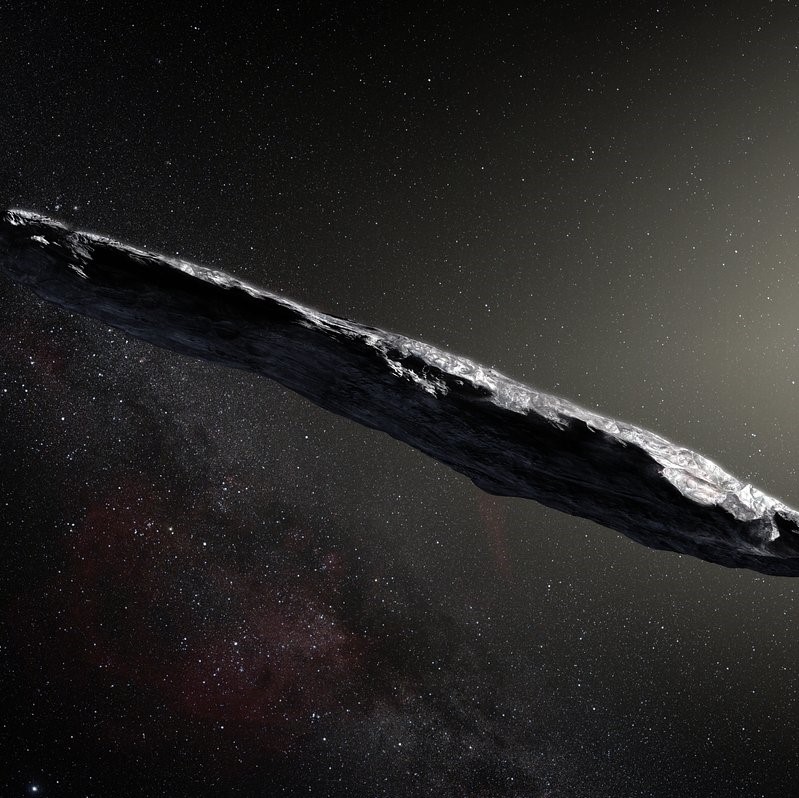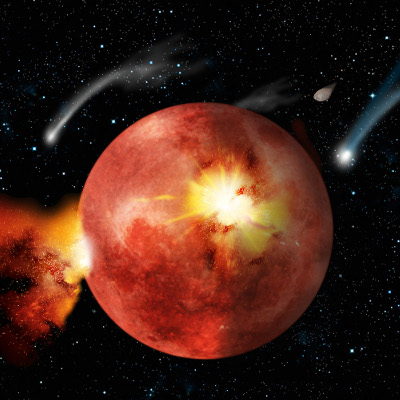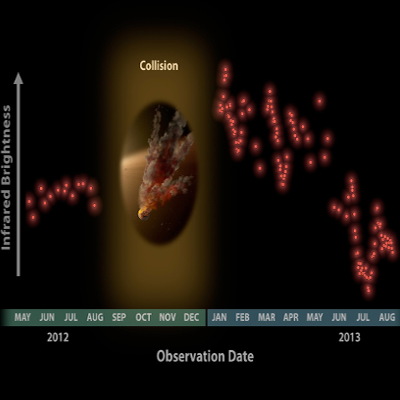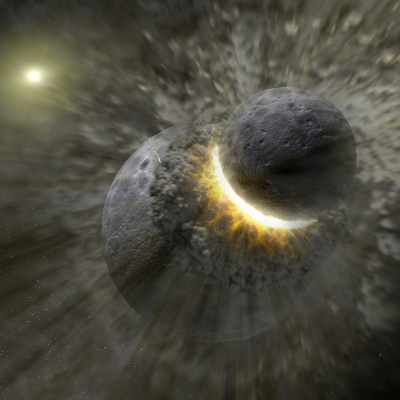Projects
-

The existence of asteroids and comets from planetary system other than our own has long been expected, since we know that asteroids and comets are ejected from own Solar system. It was not until October 2017 however that the first confirmed interstellar object, 'Oumuamua, was discovered by the Pan-STARRS survey (Meech et al. 2017). Having a small object from another planetary system that we can observe close up is very exciting as it gives us a direct window on the processes that occurred during the formation and evolution of that system that we cannot access in any other way. In addition, as is often the case when we discover the first object in a predicted class, 'Oumuamua did not quite match our expectations, which tells us that we need to update our ideas about how planetary systems form and evolve. Once the Vera Rubin Observatory starts taking data in late 2021/early 2022 we should discover many more interstellar objects, allowing us to start building a statistical picture of the small body population in other planetary systems. For objects discovered soon enough after they enter the Solar system we might even be able to send a space mission to the object.
This project is a collaboration with Steve Desch at Arizona State University
Image Credit: ESO/M. Kornmesser, artists impression of 1I/'Oumuamua
-

Large amounts of the debris released in a giant impact is eventually re-accreted, either by the progenitor body or by other planets in the system. The amount of debris generated during the course of terrestrial planet formation is significant, each individual impact releases several per cent of the mass of the colliding bodies as debris, and in total over the course of the formation of Earth-size planets debris equal to about 10-15 per cent of their final mass will have been generated (e.g. Stewart & Leinhardt 2012). As this debris will have been heavily processed within a large planetary body, as well as subjected to strong shocks during the collision, it is likely to differ chemically from material that has never been incorporated into a large body. Accretion of, and impacts with, this debris material thus might have detectable influences on the final bodies in the system, especially in the case of our own solar system. Indeed Bottke et al 2015 showed that impacts with debris from the Moon-forming impact left a detectable signature on the asteroid belt in Ar-Ar ages. I am especially interested in the possibility of debris from the final giant impacts in the solar system having left impact crater records on bodies in the inner solar system with old surfaces, such as the Moon, Mars and Mercury, as well as the asteroid belt. For the progenitor body of the debris in particular re-impacting debris would interact with any magma ocean present on the body and influence the cooling of the magma ocean and the evolution of the planetary surface.
I am the Principal Investigator for this project, which is a collaboration with Erik Asphaug and Linda Elkins-Tanton at SESE and David Minton at Purdue University, and is funded by NASA's Emerging Worlds program, grant number NNX16AI31G.
Image credit: Tim Wetherell, Australian National University, artist's impression of the Moon during the Late Heavy Bombardment
-

Giant impacts are violent events and the debris that is launched is subjected to strong shocks. The energy deposited in the debris is sufficient to vaporise substantial quantities of the material. The vapour cloud expands away from the planet and cools, eventually condensing to form droplets that are typically millimetres to centimetres in size (Melosh & Vickery 1991; Johnson & Melosh 2012, 2014). The total surface area of these vapour condensates is enormous, and can easily result in the debris cloud being optically thick. Optically thick debris is not something that is commonly considered for debris disks, and can lead to complex, variable behaviour. This variability can serve as a unique fingerprint encoding the properties of the progenitor body and its orbit and the high brightness of the vapour condensate phase may allow us to see collisions involving smaller bodies (perhaps only the size of Ceres) that would otherwise be inaccessible. The remarkable ID8 system (light-curve shown in the thumbnail) may be an example of a system in which we are seeing this kind of behaviour. This phenomenon also has important consequences for planet formation in the solar system and in exoplanetary systems and our ability to correctly recognise the debris byproducts of planet formation processes.
This project is a collaboration with Kate Su, George Rieke and Andras Gaspar at the University of Arizona.
Image credit: NASA/JPL-Caltech/University of Arizona, graphic of the light curve of the system ID8 in 2012-2013
-

It has now been widely recognised for some time that giant impacts are far from being simple perfect mergers and display a diverse range of outcomes (e.g. Agnor & Asphaug, 2004; Asphaug, 2010; Leinhardt & Stewart, 2012). Incorporating the effect of these non-perfect mergers into full N- body simulations of planet formation remains extremely challenging however, such that many studies still use the perfect merger model (e.g. Raymond et al., 2009), and the small number of studies that have attempted to investigate the influence of non-perfect mergers all have significant limitations.
Our group at ASU has a database of over 1500 smoothed-particle hydrodynamic (SPH) simulations that represents an excellent resource to help tackle this problem. This database will allow us to construct parameter space maps of the behaviour and properties of giant impact products similar to those of Leinhardt & Stewart 2012, Stewart & Leinhardt 2012 but with greater parameter resolution, and especially improving our knowledge of the smaller debris that has been less well studied in the past and is subject to scale-dependent effects. In addition we will provide constraints on the initial orbits of the impactors and probability distributions for the post-impact trajectories of the impact products. These two components combined will then allow us to construct a statistical model of the giant impact phase which will be enormously beneficial in allowing us to gain insights into the planet formation process without recourse to computationally expensive N-body simulations.
This project is being conducted in collaboration with Erik Asphaug and Travis Gabriel at SESE.
Image credit: NASA, artist's impression of the giant impact that formed the Pluto-Charon system
Image credit: NASA/JPL-caltech/SETI institute, Galileo mosaic of Europa